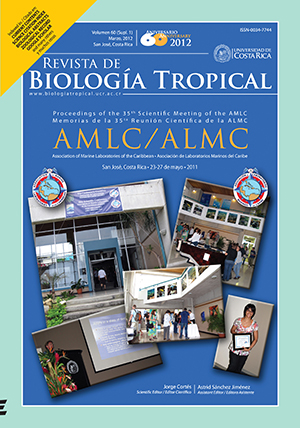Abstract
The Inlet of Xel-Ha is used as a park for ecotourism, representing a sanctuary for the conservation of Pink Queen Conch. Increasing fishing pressure has led to the inclusion of the species in CITES. Most knowledge about the growth of the queen conch was generated through aquaculture, ocean enclosures or obtained using estimates derived from population dynamics. In this study we estimated the growth rate of juvenile S. gigas in a natural protected area by direct methods, during the period of April 2009 to January 2011. Data was obtained by capture-mark-recapture sampling. 1418 individuals were tagged and growth of 714 conchs was analyzed. Population size and density was estimated using Schnabel’s method. The average density was estimated at 0.1694 ± 0.0996ind. m-2, while the highest density was estimated for September 2010 (0.3074ind. m-2). The highest growth rate (0.27 ± 0.10mm day-1) was detected in juveniles with an initial size between 100-149mm, followed by conch <100mm, with an increase of 0.24 ± 0.05mm day-1. The growth rate decreased for individuals with an initial size between 150-199mm (0.18 ± 0.09mm day-1) and for organisms > 200mm (0.08 ± 0.07mm day-1). Variability in growth rate was high in conch 100-149mm and showed seasonal differences, with the highest growth rate in May 2010. Recruitment of juveniles was highest in October 2009 and February 2010. The population of Xel-Ha has grown in size and more large and juvenile conch could be found than in previous studies, indicating that Xel-ha park is working as a sanctuary for the conservation of the queen conch in Mexico’s Riviera Maya. The growth rate of juvenile conch in Xel-Ha is high and exhibits large variations in individuals, reflecting the natural conditions of foraging and aggregation. Seasonal differences in growth rate may be associated with water quality and availability of nutrients for primary production. We conclude that the direct method is useful for the assessment of growth in juvenile S. gigas and that growth in natural conditions may be higher than in aquaculture systems. This information may be applied to fishery management as well as rehabilitation programs and aquaculture.Downloads
Download data is not yet available.

